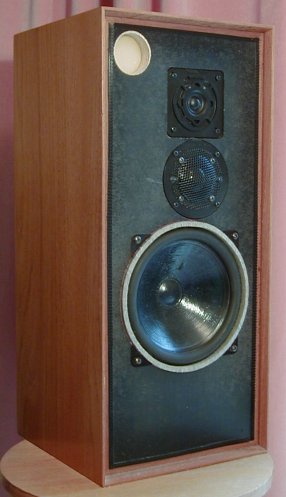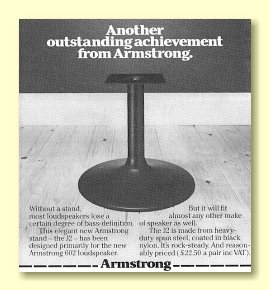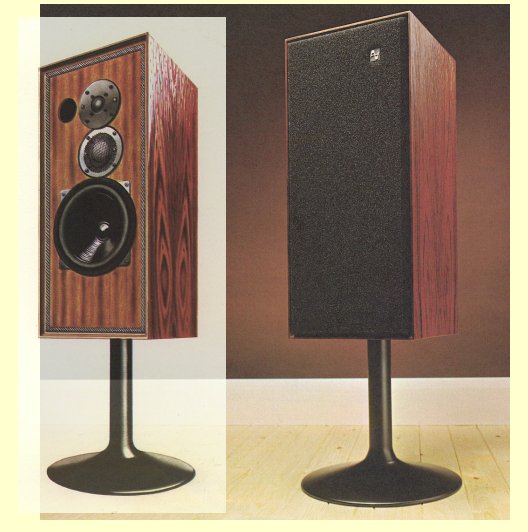The Armstrong 600 Series
The 602 Loudspeaker
The 600 range proved very successful. So much so that the most commonly asked question amongst purchasers was, “What matching speakers do you recommend? Do Armstrong make suitable ones?”
The 602 was only the second loudspeaker design that Armstrong ever produced. In general they were content to develop amplifiers, etc, and leave loudspeakers to other manufacturers. However given the popularity of the range, the frequency of the above questions, and the wish to offer something of similar performance and style, they developed the 602.
The loudspeaker was designed by Bill Purkis, who joined the company in the mid 1970's after leaving Goodmans. The design was originally intended to be an infinite baffle design, but ended up as a well-damped three-way reflex. At the time the well-known reviewer, Angus McKenzie, likened its performance to one of the (then) top-of-the-range KEF loudspeakers and rated the 602 very highly.
| Rated Power
| 100 Watts Max cont.
| Rec. Amp Power
| 25 to 100 Watts
|
| Frequency Response
| 55Hz - 20kHz ±2dB
| Crossover freqs.
| 2·3kHz & 7·5kHz
|
| Nominal impedance
| 8 Ohms
| Resonance
| 48Hz
|
| Speaker Unit sizes
| 175mm (LF)
| 38mm (mid)
| 25mm (HF)
|
| Cabinet size
| 600mm high
| 270mm wide
| 284mm deep
|
| Internal volume
| 28 Litres
| Weight
| 14·7 kg
|
 The photograph on the left shows a prototype version of the 602. Production versions had a veneered front to match their sides. As with the rest of the 600 range, the speakers were available in a choice of wood veneer finishes.
The photograph on the left shows a prototype version of the 602. Production versions had a veneered front to match their sides. As with the rest of the 600 range, the speakers were available in a choice of wood veneer finishes.
The design used three speaker units.This was because two unit designs often encounter problems in the crossover region. These can arise due to phase interference between the units (and the effect of the crossover electronics) or due to unit imperfections. For example, the bass speaker can still produce audible resonances and uneven response above the nominal crossover frequency since it may still be being driven at a low level. This can add colouration to the sound. The midrange speaker acts as a ‘filler driver’. It allows the bass speaker to be filtered off at a lower frequency, and the treble speaker to be confined to higher frequencies. This means each can perform more satisfactorily, and also reduces the demands on each unit, hence increasing the sound levels that can be produced without audible distress. The output from the midrange can also be used to correct any effects due to acoustic interference in the vital presence region.

Having produced a loudspeaker, Armstrong duly decided that it was logical to also offer a matching stand. This was the “J2” stand. Although designed for the 602 it was also made available for use with other types of loudspeaker. The stand could be screwed onto the base of a conventional wooden-boxed speaker unit. This was in the days before things like ‘floor spikes’ were considered desirable. The stand had a trumpet-like flared shape which made it quite rigid and minimised resonances. As with other items in the 600 range the J2 was designed to look good as well as work well.
The loudspeaker sold fairly well. However it only appeared a few years before manufacture of the 600 range was discontinued. So it is rarer than the amplifiers, tuners, and receivers.

Content and pages maintained by: Jim Lesurf
using HTMLEdit and TechWriter on a StrongARM powered RISCOS machine.




 The photograph on the left shows a prototype version of the 602. Production versions had a veneered front to match their sides. As with the rest of the 600 range, the speakers were available in a choice of wood veneer finishes.
The photograph on the left shows a prototype version of the 602. Production versions had a veneered front to match their sides. As with the rest of the 600 range, the speakers were available in a choice of wood veneer finishes.